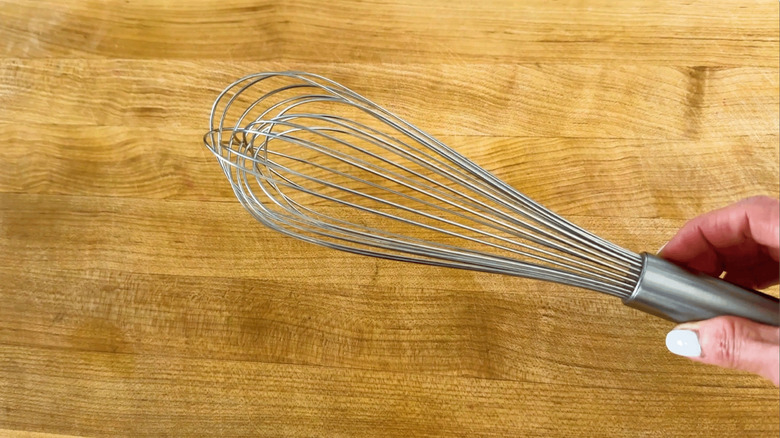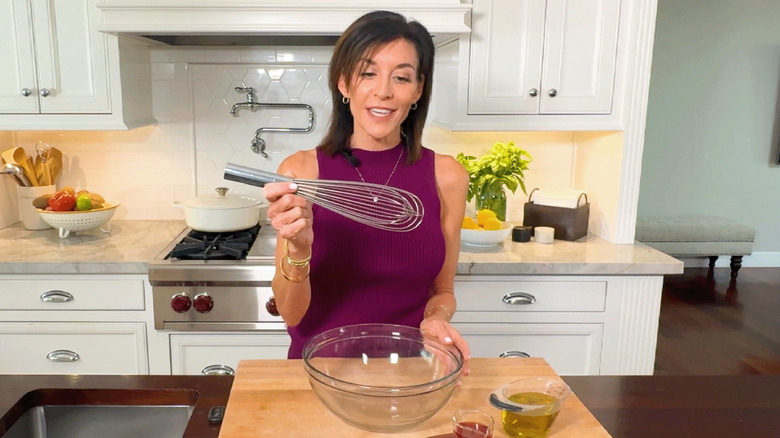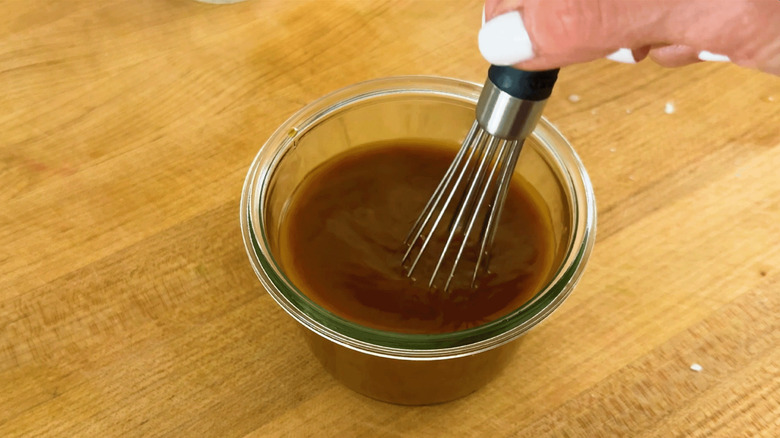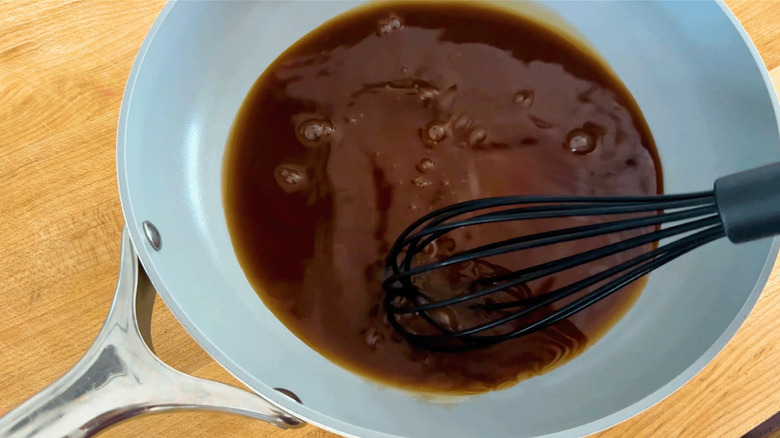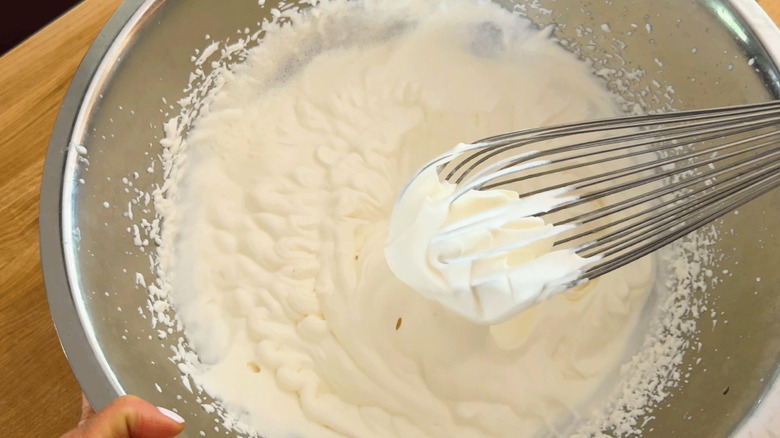How To Properly Use A Whisk - You're Doing It Wrong All Wrong
A whisk is one of those versatile kitchen tools that everyone seems to have in their first apartment, even if they don't actually cook (along with that weird spaghetti spoon with the hole in it). But it turns out there's a right way and a wrong way to use whisks, and it's possible you've been using yours wrong all along. Fortunately Chowhound recipe developer Miriam Hahn has come to the rescue in this "You're Doing It All Wrong" video. It turns out, those wire tools work much better if you use the right one for the job, and use it correctly.
"A really common mistake is using the wrong whisk for the task," says Hahn. She points out that there are several kinds of whisks, and focuses on four commonly used styles: balloon, French, silicone, and mini or mini-balloon whisks. Just as different kinds of knives have different uses and require specific skills, there are better and worse ways to swirl through eggs or batter for the best results. Hahn lays out a number of tips and techniques to ensure you start whisking things up the right way. It turns out a side-to-side motion works way better than a circular motion, and you probably should choose a much bigger bowl to do the mixing in than you think.
The balloon whisk is best for thinner liquids
You probably have a balloon whisk in your kitchen already. It's a bulbous, all-purpose whisk with flexible interlocking wires or tines, and it's one of the essential baking tools everyone should own. The large balloon shape works well in curved mixing bowls, and is useful with both wet and dry ingredients. "It is designed to bring a lot of air into whatever it is you're mixing," says Hahn before whisking cream and powdered sugar together. She recommends it for whipping cream, egg whites, soufflés, and light pancake batters, like those fluffy Japanese soufflé pancakes that have dominated social media the past few years. While balloon whisks are pretty much available anywhere, it's worth seeking out a well-constructed whisk that won't come apart on you or rust easily.
The stiffer French whisk is great for thick batters
The French whisk (sometimes called a French whip) is a narrower, sturdier version of the balloon whisk. The tines aren't as flexible and they're closer together, making the French whisk useful for thicker batters and puddings, according to Hahn. She also notes it's great for recipes requiring emulsification of the ingredients like a vinaigrette, mayonnaise, or homemade aioli recipe. To demonstrate, she combines oil and red wine vinegar for a quick dressing that doesn't easily separate.
In addition, the narrower, stiffer nature of the French whisk allows it to get into the edges of a pot or deep-sided pan better than the more flexible balloon whisk, and you can use it almost like a spatula when mixing up one of the creamier five mother sauces, like a béchamel or hollandaise. French whisks come in a variety of shapes and sizes, but often run fairly large.
Mini whisks aren't just cute
The mini balloon whisk works well with smaller containers, where aeration or emulsification aren't the goal (hence vigorous whisking isn't required). "Another common mistake is using too big a whisk for the tasks," Hahn explains, while making a stir-fry sauce. While it's basically just a tiny version of the balloon whisk, the mini whisk is designed for using in smaller bowls, and recipe components that might only be made in half-cup or smaller portions. It will whip, mix, and emulsify smaller versions of most any recipe with ease.
One key component in the stir fry recipe is a cup of cornstarch and water which works as a thickener for the sauce, which she mixes separately in its own measuring cup-sized dish. In both cases, she's combining a small volume of ingredients in a confined space, and the mini whisk works most efficiently, and reduces any mess. "This is the perfect size, in this jar, to mix this stir fry sauce," she notes.
Likewise, if you're whisking up one or two eggs in a cup, or making a single serving of tahini or tzatziki, the mini whisk works very well. There are a range of sizes available (some mini whisks are nearly as large as smaller versions of regular whisks), but for small bowls and measuring cups, six-inch versions with fairly stiff wires really get the job done.
Silicone whisks are a safe choice for nonstick surfaces
Silicone whisks, on the other hand, are best for using with non-stick cookware you want to protect, since a common mistake, according to Hahn, is using whisks made of metal which can scratch and damage coated pans. Adding the cornstarch slurry into her stir fry sauce to thicken it (one of the many tricks cornstarch can do), Hahn notes that the whisk is perfect in this situation. Arguably the whisk is better at mixing liquid ingredients than a spatula or wooden spoon.
Remember, though silicone whisks are often made in balloon whisk form, the name refers to the protective coating on the wires, not the design or size of the whisk. You can find silicone-coated versions of most any whisk style. An added advantage of the coating is that it's quieter than stainless steel while mixing against metal or glass.
Whisking side-to-side works best
The risk of doing it all wrong doesn't stop at picking the right tool. It's how you use those tools. If you've whipped your cream in brisk circular motion while tilting the bowl, you're in for a big surprise. In fact, a gentle, consistent side-to-side motion works best, according to Hahn.
"So you want to use a side-to-side motion, just kind of using your wrist," she explains. This is in contrast to a circular motion around the bowl, as if you're stirring soup while it cooks, or a rapid whipping motion with the bowl tilted. "The side-to-side is going to be the most effective," says Hahn. The combination of the motion and the balloon whisk should yield stiff peaks in your whipped cream in just a few minutes.
Side-to-side whisking creates a better shear force, creating layers of liquid that as they collide, create long air channels and better combine and aerate the ingredients. It's also an easier motion to repeat consistently, without tiring, than the looping whip used against the side of a dish.
However you choose to whisk, Hahn points out you should be using the largest bowl you can. It prevents spills, and is easier and less cumbersome to work with. Whisking in a large bowl is particularly helpful when aerating (like with whipped cream), as it gives you room to work vigorously, and allows space for the cream or batter to expand in size as it absorbs air. When you choose the right whisk, keep your wrist motions on point, and reach for the right bowl, you'll be well on your way to perfectly-whisked ingredients every time.
